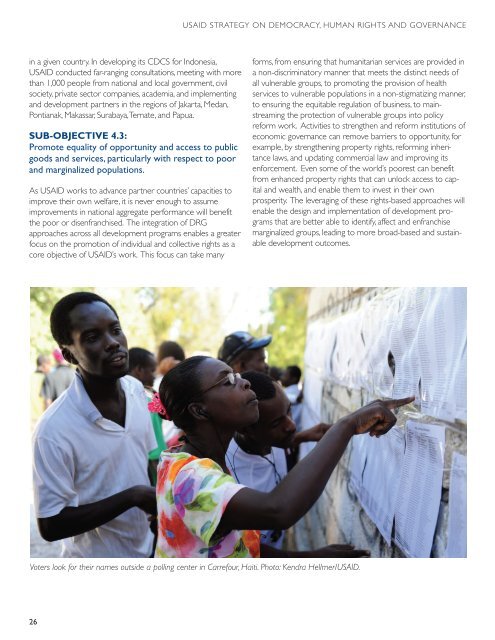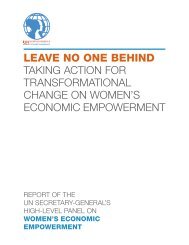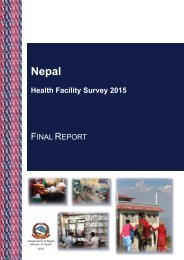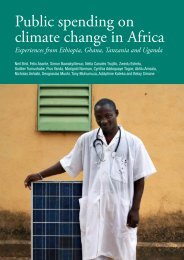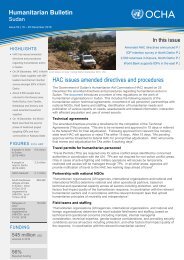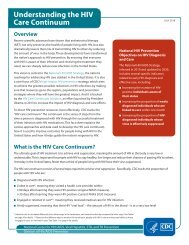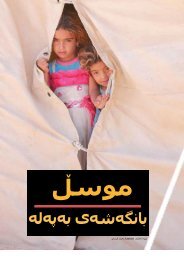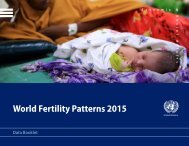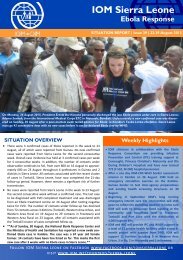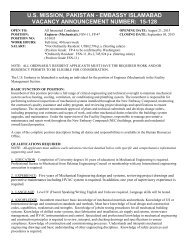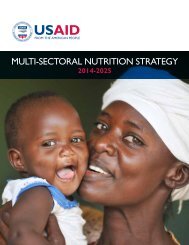<strong>USAID</strong> STRATEGY ON DEMOCRACY, HUMAN RIGHTS AND GOVERNANCEin a given country. In developing its CDCS for Indonesia,<strong>USAID</strong> conducted far-ranging consultations, meeting with morethan 1,000 people from national and local government, civilsociety, private sector companies, academia, and implementingand development partners in the regions of Jakarta, Medan,Pontianak, Makassar, Surabaya,Ternate, and Papua.SUB-OBJECTIVE 4.3:Promote equality of opportunity and access to publicgoods and services, particularly with respect to poorand marginalized populations.As <strong>USAID</strong> works to advance partner countries’ capacities toimprove their own welfare, it is never enough to assumeimprovements in national aggregate performance will benefitthe poor or disenfranchised. The integration of <strong>DRG</strong>approaches across all development programs enables a greaterfocus on the promotion of individual and collective rights as acore objective of <strong>USAID</strong>’s work. This focus can take manyforms, from ensuring that humanitarian services are provided ina non-discriminatory manner that meets the distinct needs ofall vulnerable groups, to promoting the provision of healthservices to vulnerable populations in a non-stigmatizing manner,to ensuring the equitable regulation of business, to mainstreamingthe protection of vulnerable groups into policyreform work. Activities to strengthen and reform institutions ofeconomic governance can remove barriers to opportunity, forexample, by strengthening property rights, reforming inheritancelaws, and updating commercial law and improving itsenforcement. Even some of the world’s poorest can benefitfrom enhanced property rights that can unlock access to capitaland wealth, and enable them to invest in their ownprosperity. The leveraging of these rights-based approaches willenable the design and implementation of development programsthat are better able to identify, affect and enfranchisemarginalized groups, leading to more broad-based and sustainabledevelopment outcomes.Voters look for their names outside a polling center in Carrefour, Haiti. Photo: Kendra Hellmer/<strong>USAID</strong>.26
<strong>USAID</strong> STRATEGY ON DEMOCRACY, HUMAN RIGHTS AND GOVERNANCEV. IMPLEMENTING THE<strong>DRG</strong> STRATEGYBecause political change happens at the country level,<strong>USAID</strong> will primarily implement the global <strong>DRG</strong> StrategicFramework through the development and implementationof country-appropriate <strong>DRG</strong> strategies that are guided byrealities on the ground. 29 With the support of regional andglobal operating units and other USG counterparts, <strong>USAID</strong> Missionswill play the primary role in implementing this strategy byboth designing and implementing <strong>DRG</strong> focused programs, andintegrating <strong>DRG</strong> principles and practices throughout the ProgramCycle.As <strong>USAID</strong> Missions develop, design and implement their <strong>DRG</strong>strategies, they should be guided by three factors :■ The <strong>USAID</strong> <strong>DRG</strong> Strategic Framework: Thestrategic framework, described earlier, is used by Missions todefine and develop programmatic priorities. A Mission’s“core” <strong>DRG</strong> portfolio should be consistent with DOs 1-3,while the remainder of the Mission portfolio should incorporatethe principles set forth in DO 4. By focusing on higherlevel goals, this strategic framework encourages resultsdrivenprogram design and planning that transcends the fourtraditional sub-sectoral areas of elections, civil society, governanceand rule of law, as well as integrates <strong>DRG</strong> into theMission’s other DOs.■ Country Context: Successful Mission <strong>DRG</strong> strategicapproaches will be based on clearly defined priorities guidedby their unique country context.To ensure that thesechoices are fully informed, this strategy outlines a range ofcountry contexts that can help Missions identify high-levelstrategic priorities that may be suited to the <strong>DRG</strong> needs intheir country. These country types provide broad outlines oflikely challenges faced, as arrayed on a spectrum of politicalfreedom and competition, as well as overarching considerationssuch as conflict and transitions. This approach will helpMission management identify higher-level policy issues, helpinform interagency and bilateral strategic dialogues, and allow<strong>DRG</strong> officers to benefit from general lessons learned from<strong>USAID</strong> strategies undertaken in similar country contexts.■ <strong>DRG</strong> Assessments and Social-Sector PoliticalEconomy Analysis (PEA): Strategy and program designdepends on solid country-specific information and analysis.Thus, it is recommended that Missions conduct a <strong>DRG</strong>assessment using <strong>USAID</strong>’s <strong>DRG</strong> Strategic Assessment Framework.In addition, political economy analysis will contribute tothe development of integrated programs under DO 4 andshould be applied generally to sectors across <strong>USAID</strong>’s portfolio,such as health, economic growth and food security.Other analytical tools, such as <strong>USAID</strong>’s Constraints to GrowthAnalysis and cost-benefit analysis, can provide rich understandingof the social dynamics underlying reform efforts. 30DEFINING COUNTRY CONTEXTA country’s political system and trajectory is one of the moresignificant factors in determining what the core <strong>DRG</strong> challenges,priorities, and opportunities are in a given country. Thedegree of political openness and competition, including economiccompetition, greatly influences the nature of the <strong>DRG</strong>challenges in a country, and shapes the opportunities for <strong>DRG</strong>programming.<strong>USAID</strong> works in three (authoritarian, hybrid, developingdemocracies) of the four country contexts discussed below.While some countries will fit neatly in one of these contexts,many will not. Some countries will have uneven developmentand have characteristics straddling different contexts. Trajectorieswill also differ, with some countries progressing and othersbacksliding.29For the purposes of this section, a country <strong>DRG</strong> strategy is defined as the <strong>DRG</strong> portion of existing Mission planning process, both formal ones such as the CDCS(Country Development Cooperation Strategies) or informal ones. These country-level <strong>DRG</strong> strategies should feed into CDCSs, program design and other <strong>USAID</strong> planningprocesses. While considered best practice and consistent with <strong>USAID</strong>’s internal document <strong>USAID</strong> Democracy, Human Rights and Governance Strategic Assessment Frameworkfor Strategy Development, a separate <strong>DRG</strong> country strategy is not required nor will such a strategy be formally reviewed.30<strong>USAID</strong> has developed an Inclusive Growth Diagnostic based on the binding constraints work of Ricardo Hausmann, Dani Rodrik, and Andrés Velasco, “Growth Diagnostics,”(Cambridge: Harvard University, October 2004).27
- Page 2: America does not presume to know wh
- Page 8 and 9: USAID STRATEGY ON DEMOCRACY, HUMAN
- Page 10 and 11: USAID STRATEGY ON DEMOCRACY, HUMAN
- Page 12 and 13: USAID STRATEGY ON DEMOCRACY, HUMAN
- Page 14 and 15: USAID STRATEGY ON DEMOCRACY, HUMAN
- Page 16 and 17: USAID STRATEGY ON DEMOCRACY, HUMAN
- Page 18 and 19: USAID STRATEGY ON DEMOCRACY, HUMAN
- Page 20 and 21: USAID STRATEGY ON DEMOCRACY, HUMAN
- Page 22 and 23: USAID STRATEGY ON DEMOCRACY, HUMAN
- Page 24 and 25: USAID STRATEGY ON DEMOCRACY, HUMAN
- Page 26 and 27: USAID STRATEGY ON DEMOCRACY, HUMAN
- Page 28 and 29: USAID STRATEGY ON DEMOCRACY, HUMAN
- Page 32 and 33: USAID STRATEGY ON DEMOCRACY, HUMAN
- Page 34: USAID STRATEGY ON DEMOCRACY, HUMAN
- Page 37 and 38: USAID STRATEGY ON DEMOCRACY, HUMAN
- Page 39 and 40: USAID STRATEGY ON DEMOCRACY, HUMAN
- Page 41 and 42: USAID STRATEGY ON DEMOCRACY, HUMAN
- Page 43 and 44: USAID STRATEGY ON DEMOCRACY, HUMAN
- Page 45 and 46: ANNEX I1I. BUILDING ON THELAST 20 Y
- Page 48: U.S.Agency for International Develo


